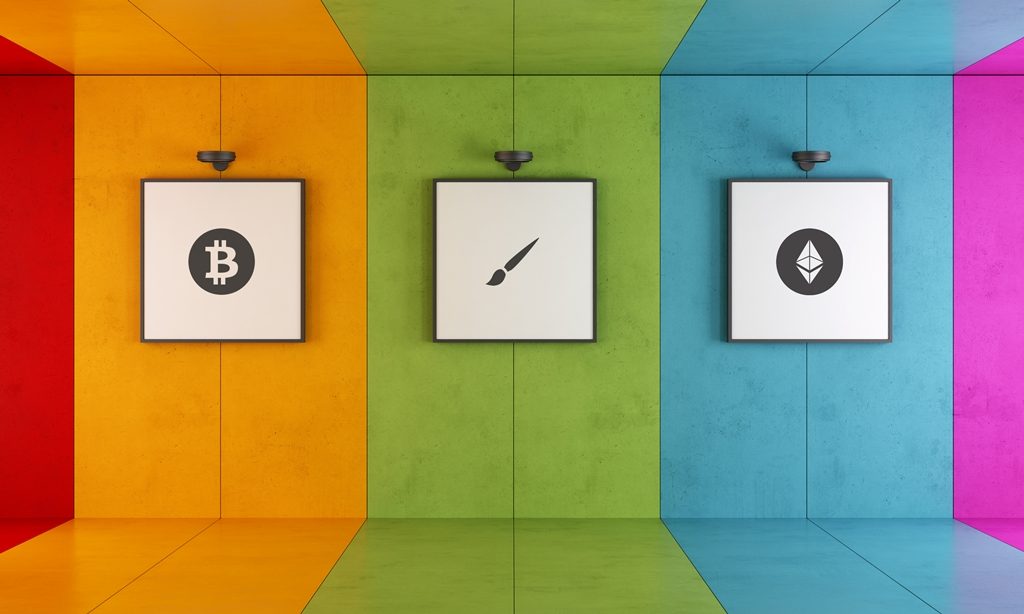
The intersection between Crypto and artistic expression is perhaps not the first connection to come to mind. However, if you’re the kind of person who sees potential for Bitcoin and blockchain technology to reshape existing institutions, give rise to new types of organisations, or generally change the world, then there is a good reason to check out the artists working with these ideas.
Blockchain and Cryptocurrency in Art
Historically, it has always been the artists who are on the front lines of culture, creating new ideas, styles, representations of reality and forms of expression that lay the foundation of the future. What is considered radical in one generation is often normalised by the next, and artists tend to push those boundaries, break down barriers, and challenge us to think in new ways. So, when creative people start to use Bitcoin and cryptocurrency in art, it is worth paying attention.
Since its inception, there have been a number of artists who have made use of cryptocurrency in art. Ranging from imaginative portraits of Satoshi Nakamoto to decentralised art marketplaces built on blockchain, there are far too many unique and varied projects to cover in one article. We will, however, look at a few particularly notable examples of cryptocurrency in art.
Hidden Treasures
Perhaps one of the most famous, and certainly one of the most creative, incorporations of cryptocurrency in art is a painting created by Twitter artist @coin_artist in 2015. The artist posted the image to Twitter with an alluring caption:
https://twitter.com/coin_artist/status/583979278238359552
While initial interest in solving the puzzle was substantial, the painting’s secret code proved quite challenging to crack. It wasn’t until three years later, perhaps uncoincidentally during the bull run of 2017, that cracking the painting’s code was met with renewed enthusiasm. The complex keys and ciphers represented by different elements of the painting were finally solved in February of 2018 by a programmer and puzzle enthusiast.
Twitter’s @coin_artist is not the only creator embedding secret cryptos in artworks. Los Angeles-based artist Andy Bauch has also produced several intricate mosaics made of legos that conceal hidden crypto fortunes. Part of Bauch’s “New Money” series displayed at the Castelli Art Space in March of 2018, each of the mosaics contains the private key to one of his crypto wallets to anyone who can decipher it. In describing his inspiration for using cryptocurrency in art Bauch said, “I am attempting to help those without computer science backgrounds visualize and understand the rather abstract concept of cryptocurrencies and simultaneous democratizing the potential and volatility that comes along with them.”
Digital Graffiti on the Blockchain
While some artists hide cryptocurrency in art, others hide art in cryptocurrency – or, more specifically, on the blockchain. Since the beginning of Bitcoin, people have embedded hidden text and images in the blockchain using the transaction address system. Satoshi Nakamoto, in fact, was the first to do this, including the hidden note, “Chancellor on brink of second bailout for banks,”
in the genesis block of the Bitcoin blockchain.
One project that focuses on this unique integration of cryptocurrency in art is an interactive installation deployed as a repository on Github called Messages from the Mines. According to the creator of this fascinating twist on the traditional block explorer, “the distributed ledger contains hidden love messages, cryptic poems, ASCII art, signatures, eulogies and more. These messages are a creative misuse of the Bitcoin transaction protocol, a form of digital graffiti, unique—though overlooked—cultural artifacts forever embedded in one of the most contemporary digital technologies.”
CryptoKitties
Love ‘em or hate ‘em, there is no question that CryptoKittes got people all over the world really excited about the implications for cryptocurrency in art. In December, 2017, CryptoKitties made a huge splash in the crypto space. Launched on the Ethereum blockchain, CryptoKitties are adorable cartoon cats that you can buy, sell, and breed. Any two CryptoKitty owners can breed their cats to create a new, unique CryptoKitty, which can then be sold on a marketplace.
These collectable digital kitties became so popular that they caused serious congestion on the Ethereum network and slowed transaction speed to a crawl. Like other collectables, each CryptoKitty is imbued with a certain level of rarity. While the average price is around $25, the rarest CryptoKitty was sold for over $100,000.
What’s Next?
As more artists explore the world of blockchain and find creative ways to incorporate cryptocurrency in art, we can look forward to more projects that explore the space around art and technology. We are also beginning to see applications for blockchain in relation to art ownership, distribution, authentication, and licensing. Ranging from decentralised digital art marketplaces built on the blockchain to opportunities for democratising investment in fine art, we are just beginning to explore the true implications for cryptocurrency in art.



